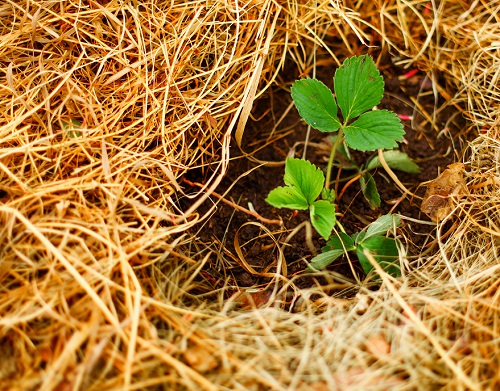Gail Nonnecke
Horticulture Professor
515-294-0037
nonnecke@iastate.edu
There is still plenty to do in the garden during the fall in preparation for winter. In this installment of Yard and Garden, Iowa State University horticulture expert Gail Nonnecke discusses the steps to take to prepare fruits for winter.
How should I prepare my strawberry bed for winter?
Strawberries should be mulched in fall to prevent winter injury. Low temperatures and repeated freezing and thawing of the soil through the winter months are the main threats to strawberry plants. Temperatures below 20 degrees Fahrenheit may kill flower buds and damage the roots and crowns of unmulched plants. Repeated freezing and thawing of the soil can heave plants out of the ground, severely damaging or destroying the plants.
Excellent mulching materials include clean, weed-free oat, wheat or soybean straw. Chopped cornstalks are another possibility. Apply approximately 3 to 5 inches of material. After settling, the mulch layer should be 2 to 4 inches thick.
In windy, exposed areas, straw mulches can be kept in place by placing wire or plastic fencing over the area. The fencing can be held in place with bricks or other heavy objects.
When should I mulch my strawberries?
Allow the strawberry plants to harden or acclimate to cool fall temperatures before mulching the bed. In northern Iowa, strawberry plantings are normally mulched in early November. Gardeners in central and southern Iowa should mulch their strawberries in mid-November and late November, respectively.
Are black raspberries hardy in northern Iowa?
Red and purple raspberries are hardy throughout the state. Black raspberries, however, often suffer severe winter damage in northern Iowa and can be reliably grown only in central and southern portions of the state. Black Hawk (an Iowa State University introduction) is the hardiest black raspberry cultivar.
Can I prune my red raspberries back to the ground in late fall?
The growth and fruiting characteristics of raspberries are unique. The plant’s roots and crown are perennial, while the stems or canes are biennial. A raspberry plant may survive and produce fruit for many years. However, individual canes live only two years and then die.
There are two types of red raspberries. Summer-bearing red raspberries are strictly vegetative during the first growing season. The following year, these same canes flower, produce fruit, and then die.
The growth and fruiting characteristics of fall-bearing red raspberries are slightly different. Fall-bearing varieties naturally produce two crops. The first crop is produced in late summer or early fall at the tips of the current season’s growth. The following year, a summer crop is produced on the lower portions of these same canes. After the second crop, the canes die.
Many gardeners with fall-bearing red raspberries prune them back to the ground in late fall or early spring. Doing so eliminates the summer crop, but allows the late summer/early fall crop to mature one to two weeks earlier. In addition, total crop yields are larger using the one-crop system versus the two-crop system.
Summer-bearing red raspberries should not be pruned back to the ground in late fall or early spring. Pruning summer-bearing red raspberries back to ground level will eliminate the following season’s crop.
How should I prepare my fruit trees for winter?
Rabbits pose a threat to small fruit trees over winter. In winter, rabbits often gnaw on the bark of many woody plants. Heavy browsing can result in the complete girdling of small trees. Girdled fruit trees are essentially destroyed.
The best way to prevent rabbit damage to young fruit trees is to place cylinders of hardware cloth around the tree trunks. The hardware cloth cylinder should stand 1 to 2 inches out from the tree trunk and extend 10 to 12 inches above the expected snow depth. The bottom 2 inches should be buried beneath the soil.
Fruit trees planted within the last two or three years should be watered deeply before winter if the weather in fall has been dry.
Gail Nonnecke can be reached at nonnecke@iastate.edu

